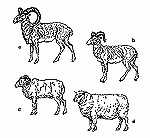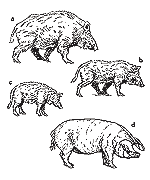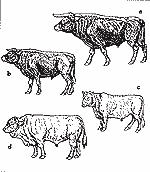
Animal husbandry is the domestication and systematic rearing of animals in order to control and increase production. In this way, different kinds of wild animals became domesticated providing thus on a permanent basis a supply of their products which were of importance for the nutrition of humans. Farming along with agriculture characterized the economy of the Neolithic period.
Wolves and dogs were the first species of wild animals to accompany hunters in central Europe during the Upper Palaeolithic (ca. 13,000 BC). Dogs were tamed and became a domesticated animal-companion of man in the Near East around 10,000 BC.

Domestication and systematic animal rearing did not occur simultaneously
in every part of the earth. The first indications come from the region
of the "Fertile Crescent" in the second
half of the 8th millennium BC. The first animals to be domesticated were
sheep (from the sheep Mufflon) and goats (from the goat Berzoar)
around 7500 BC. Then followed the pig (ca. 7000 BC) and cattle (ca. 6500
BC).

Meat, milk, leather, wool and bones (used as a raw material for the manufacture of tools) were the products obtained from the first domesticated animals. Cattle, due to their physical strength, were additionally used for various farming tasks and as a means of transport. From the 4th millennium BC, when the cultivation of the land with the plough in south Mesopotamia began, humans depended on cattle to assist them in all their farming tasks. After the 5th millennium BC a kind of fast dog especially trained for hunting appeared, similar to the one that currently accompanies Bedouins.

In Asia Minor and in the Aegean, around the middle of the 7th millennium BC, five species of domesticated animals (sheep, goat, pig, cattle, dog) have been traced. However, in the Balkans and in the rest of Europe the first indications appear in the middle of the 7th millennium BC. The domestication of the horse took place in Europe and more specifically in the Ukraine during the 3rd millennium BC.





